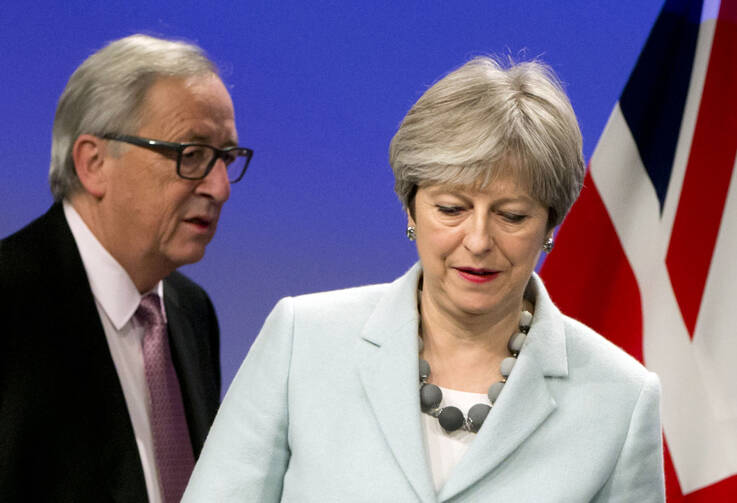A little over a century ago, Dublin’s General Post Office on O’Connell Street shuddered from the rifle fire of the Easter Rising. One imperfect, blood-soaked outcome of the rebellion was the partition of the island—the “terrible beauty” of Yeats. The neuralgic “Irish Question,” as the Brits call it (Irish people are less convinced that they are the problem) was not properly solved in the early 20th century and, despite the imaginative and largely effective Good Friday Agreement of April 1998, it has resurfaced again. Now it has thrown an already chaotic set of negotiations over Britain’s “Brexit” from the European Union into further confusion, if not farce.
Those negotiations, already faltering, seemed headed for collapse over three central issues, which the European team insist be resolved before talks on new trading arrangements, post-March 2021, could begin. The toughest roadblock has been the status of the border—and specifically the avoidance of a “hard” border—between Ireland and Northern Ireland. Also, there has been no agreement on the future rights of European Union citizens living in Britain or on the “divorce bill.” (London’s obligations to the E.U. could amount to 60 billion euros.) Finally, after a week of strenuous deliberations and an all-night negotiating marathon, a specialty of European politics, just before breakfast on Dec. 8, both sides were able to announce agreement on wording that would avoid customs and border posts on the Irish border and open the road to the long-delayed next phase of negotiations.
Both sides were able to announce agreement on wording that would avoid customs and border posts on the Irish border.
Earlier in the week, the London team thought they had clinched it. Media briefings suggested a diplomatic triumph for the Brits. Finally, after many contradictory statements from British politicians, some measure of agreement was reached on language that would suit everyone. British Prime Minister Theresa May dashed to Brussels for lunch with E.U. Commission President Jean-Claude Juncker fully expecting to sweeten their desserts with an announcement that a deal had been done on the border issue. But somewhere between the meat and cheese courses, it all went pear-shaped.
Ms. May was called away to take a call from Northern Ireland leader Arlene Foster. By the time she resumed her seat, her coffee was cold, the ice cream had melted and hopes of a deal had been poured down the waste-disposal unit. The Unionists in Northern Ireland had, at the last minute, rejected the deal. Ms. May had controversially bought the parliamentary support of Ms. Foster’s hard-line Democratic Unionist Party, the political wing of the Free Presbyterian Church of Ulster that fiercely opposes Irish unification and has a long history of anti-Catholicism, to prop up her Westminster majority and keep her in power after her ill-conceived snap election earlier this year. Now the Unionists, even before the coffee was served, were presenting their bill. Fearing their worst nightmare, a united Ireland, they have found themselves power brokers because Ms. May’s Tories need them for parliamentary life-support.
The Unionists have found themselves power brokers because Ms. May’s Tories need them for parliamentary life-support.
When a slim majority of the Brits who bothered to vote in June 2016 chose to take Britain out of the European Union, a murmured snag about the border had occasionally arisen but, beyond the divided island of Ireland, caused little concern. Now the border between the Republic of Ireland and Britain is a major feature in the negotiations. Differences in regulations between Britain and Ireland would necessitate a “hard border,” either on the Irish island or, effectively, in the Irish Sea. But practically the only position held by all parties to the discussion, including the Unionists, is that nobody wants a hard border, not least because it would mean a return to pre-1998 conditions and risk reviving sectarian and violent conflicts. That hard-won 1998 agreement has at least brought two decades of mostly peaceful coexistence and free cross-border movement of goods and people, even as some underlying tensions remain.
The Irish government, too, opposes a hard border. Prime Minister Leo Varadkar clearly surprised London by forcefully defending his nation’s interests, although British “Brexiteers” used compliant media channels to suggest that he was taking his orders from Brussels. Mr. Varadkar argues that, if only Britain were to remain in the European customs union and single market, the hard-border conundrum could be resolved, for there would be regulatory convergence. But the London government, perhaps going beyond what most Leave voters thought they were asking for, has so far ruled out seeking such an arrangement.
The Irish border matter is one of many tortuous questions that have arisen since the Brexit vote. Like many other issues, it was hardly mentioned in the referendum campaign, by either side. Other arguments, notably the notorious claim from the Leavers that huge amounts of public cash would no longer be remitted to Brussels but given to the National Health Service, predominated, only to be revealed as false claims—or fake news, if you will.
In sum, the Republic of Ireland is fully in the Union, fully committed to all aspects of membership. But the northeast corner of the island, legally Northern Ireland and colloquially “The Six Counties” or just “The North,” is part of the current United Kingdom. Regardless of how it voted in the referendum (like Scotland and London, it voted to remain), it will come out of the European Union on March 29, 2019, together with the other three nations of this shaky kingdom. Since the Good Friday Agreement, which itself followed a referendum, the border has been completely open. But the bullet holes on Dublin’s General Post Office remain visible, a reminder of those days of 1916, when Britain failed to recognize legitimate Irish aspirations. That failure only encouraged further polarization on that island. History may repeat itself, if the center cannot hold.










